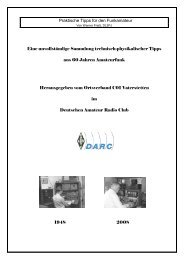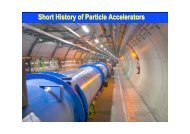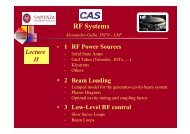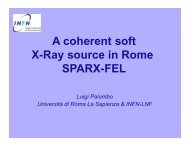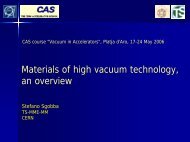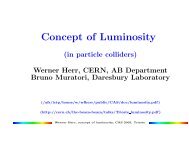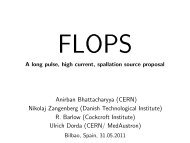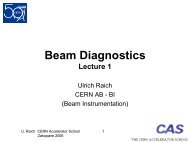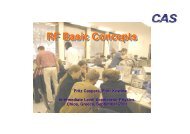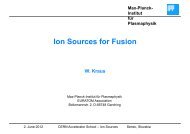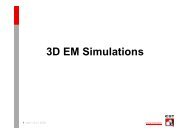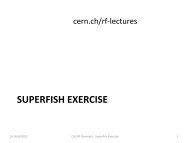High Field Magnets - CERN Accelerator School
High Field Magnets - CERN Accelerator School
High Field Magnets - CERN Accelerator School
You also want an ePaper? Increase the reach of your titles
YUMPU automatically turns print PDFs into web optimized ePapers that Google loves.
CAS-CHIOS-HFM G. de Rijk, 28 Sept. 2011<br />
CAS-CHIOS-HFM G. de Rijk, 28 Sept. 2011<br />
<strong>High</strong> <strong>Field</strong> <strong>Magnets</strong><br />
Gijs de Rijk<br />
<strong>CERN</strong><br />
CAS<br />
Chios, Greece, 28 September 2011<br />
<strong>High</strong> <strong>Field</strong> <strong>Accelerator</strong> <strong>Magnets</strong><br />
• Introduction: magnetic field and high field magnets<br />
• How to get high fields in accelerator dipole and quadrupole magnets ?<br />
• Superconductors for magnets<br />
• Practical accelerator magnet design<br />
• <strong>High</strong> field magnets for future accelerators<br />
• Literature on <strong>High</strong> <strong>Field</strong> <strong>Magnets</strong><br />
1 1<br />
2
CAS-CHIOS-HFM G. de Rijk, 28 Sept. 2011<br />
CAS-CHIOS-HFM G. de Rijk, 28 Sept. 2011<br />
y (mm)<br />
100<br />
Magnetic fields<br />
From Ampere’s law with no time<br />
dependencies<br />
(Integral form)<br />
80<br />
60<br />
40<br />
20<br />
We can derive the law of Biot and Savart<br />
0<br />
0 20 40 60 80 100<br />
x (mm)<br />
Courtesy E. Todesco<br />
<br />
B ⋅ d ∫ l<br />
C<br />
= µ 0 I encl.<br />
<br />
B = µ 0 I<br />
2πr ˆϕ<br />
If you wanted to make a B = 8 T magnet with just two infinitely<br />
thin wires placed at 50 mm distance one needs : I = 5!10 5 A<br />
LHC dipole coil 80 turns of 11850 A at 8.3 T = 9.48!10 5 A )<br />
" To get high fields ( B > 10 T) one needs very large currents in<br />
small volumes<br />
For LHC dipole@8.3 T ~1 MA in 3300 mm 2 : ~300 A/mm 2<br />
(overall current density in the coil area)<br />
Iron magnets “resistive” or “classical” magnets<br />
Example: C shaped dipole for<br />
accelerators<br />
Yoke<br />
<br />
H ⋅ d ∫ l = N ⋅ I<br />
C<br />
N ⋅ I = Hiron ⋅liron + Hairgap ⋅lairgap ⇒<br />
N ⋅ I = B<br />
µ 0µ r<br />
N ⋅ I = lairgap ⋅ B<br />
µ 0<br />
coil<br />
B = 1.8 T<br />
Gap = 50 mm<br />
N . I = 71619 A<br />
2 x 36 turn coil<br />
I = 1000 A<br />
@5 A/mm 2 , 200 mm 2<br />
14 x 14 mm Cu<br />
⋅l iron + B<br />
µ 0<br />
µ r<br />
9000<br />
8000<br />
7000<br />
6000<br />
5000<br />
4000<br />
3000<br />
2000<br />
1000<br />
0<br />
⋅l airgap ⇒<br />
This is valid as µ r >> µ 0 in<br />
the iron : limited to B < 2 T<br />
µ r"as"func)on"of"B"for"low"carbon"magnet"steel"<br />
(Magne)l"BC)"<br />
0 0.5 1<br />
B (T)<br />
1.5 2<br />
3<br />
4
CAS-CHIOS-HFM G. de Rijk, 28 Sept. 2011<br />
H magnet type MBB<br />
B = 2.05 T<br />
Coil : 16 turns<br />
I max = 4900 A<br />
Aperture = 52 × 92 mm2 g. 37: The two types of bending magnets of the SPS.<br />
L = 6.26 m<br />
Weight = 17 t<br />
!<br />
!<br />
!<br />
Fig. 38:<br />
CAS-CHIOS-HFM G. de Rijk, 28 Sept. 2011<br />
J: few x 10<br />
thetemperature<br />
Extraction elements of the SPS.<br />
3 A/mm2 inside the<br />
superconductor<br />
Resistive accelerator magnet example: SPS dipole<br />
Whenafieldishigh?<br />
Superconductormay<br />
Superconducting<br />
reachmore<br />
Thefieldthatcanbe<br />
reacheddependson<br />
Superconductors<br />
Below a the critical surface the material is<br />
“superconducting”. Above the surface it is<br />
“normal conducting”<br />
• Θ c Critical Temperature (at zero field and<br />
current density)<br />
• B c2 Critical <strong>Field</strong> (at zero temperature and<br />
current density)<br />
• J c Critical Current Density ( at zero<br />
temperature and field)<br />
Scnotonlyreachhigh<br />
fieldbutalsotheydo<br />
notdissipate!<br />
2<br />
The Critical surface depends on the material<br />
type Nb-Ti, Nb3Sn, etc) and the processing<br />
means: R = 0<br />
The critical surface of niobium<br />
J c<br />
Critical surface<br />
for Nb-Ti<br />
ty (kA.mm-2 Current densi )<br />
5<br />
• Niobium titani<br />
‘work horse’ o<br />
business<br />
• it is a ductile a<br />
• picture shows<br />
the boundary b<br />
normal resistiv<br />
• superconductiv<br />
below the surfa<br />
above it<br />
θ θc • we define an u<br />
temperature an<br />
Bc2 temperature θc which are char<br />
composition<br />
Courtesy M. Wilson<br />
• critical current<br />
processing<br />
Courtesy L. Rossi<br />
6<br />
Martin Wilson Lecture 1 slide 3 Superconducting <strong>Magnets</strong> for Acc<br />
2008
CAS-CHIOS-HFM G. de Rijk, 28 Sept. 2011<br />
CAS-CHIOS-HFM G. de Rijk, 28 Sept. 2011<br />
<strong>High</strong> field magnets example: resistive solenoids<br />
<strong>High</strong> field resistive solenoids<br />
• Onion shells of coils<br />
• <strong>High</strong> power consumption<br />
Institutes:<br />
NHFML, National <strong>High</strong> Magnetic<br />
<strong>Field</strong> Laboratory, Tallahassee,<br />
Florida (US)<br />
45 T Hybrid magnet, Ø 32mm,<br />
Power: 33 MW<br />
HFML, <strong>High</strong> <strong>Field</strong> Magnet<br />
Laboratory, Nijmegen (NL)<br />
33.0 T Bitter magnet , Ø 32mm<br />
Power: 17 MW<br />
LNCMI, Laboratoire National<br />
des Champs Magnétique<br />
Intenses, Grenoble (Fr)<br />
35 T Hybrid magnet, Ø 34mm 7<br />
Superconducting <strong>Accelerator</strong> dipole magnets (1)<br />
Tevatron: 4.4 T<br />
1983<br />
HERA: 5 T<br />
1992<br />
RHIC: 3.5 T<br />
2000<br />
Superconducting<br />
Magnet Division<br />
LHC: 8.34 T<br />
2008<br />
RHIC: Relativistic Heavy Ion Collider<br />
RHIC Arc Dipole Coldmass<br />
Courtesy R. Gupta<br />
January 16-20, 2006, Superconducting <strong>Accelerator</strong> <strong>Magnets</strong> Slide No. 14 of Lecture 1 (Introduction)<br />
8<br />
Ramesh Gupta, BNL
CAS-CHIOS-HFM G. de Rijk, 28 Sept. 2011<br />
CAS-CHIOS-HFM G. de Rijk, 28 Sept. 2011<br />
The beginning …<br />
with a footnote<br />
Superconducting <strong>Accelerator</strong> dipole magnets (2)<br />
9 9 90 90 90 90 5740.98 5740.98 5740.98 5740.98 89,79 89,79 3 3 3 3 90 90 90 90 47//0 47//0 47//0 47//0 ,33:, ,33:, ,33:, ,33:, 574/:.943 574/:.943 574/:.943 574/:.943<br />
<br />
41 41 41 34-:2 34-:2 34-:2 34-:2 99,3:2 99,3:2 99,3:2 99,3:2 <br />
<br />
-% -% -% -%<br />
,8 ,8 ,8 ,8 ;07 ;07 ;07 ;07 10 10 10 10 :3/70/ :3/70/ :3/70/ :3/70/ <br />
%0 %0 %0 %0 2,3:1,.9:70 2,3:1,.9:70 41 41 90 90 90 90 %0;,9743 %0;,9743 2,3098 2,3098 2,3098 2,3098 706:70/ 706:70/ 706:70/ 706:70/ 2470 2470 9,3 9,3 9,3 9,3<br />
41 41 -% -% -% -%<br />
%0;,9743 %0;,9743 %0;,9743 /5408 /5408 /5408 /5408 %<br />
830 830 830 ,5079:70 ,5079:70 ,5079:70 ,72 ,72 ,72 40 40 40<br />
“ The manufacturing technology and capacity<br />
developed in response to this demand made<br />
possible a new medical diagnostic method ”<br />
magnetic resonance imaging, MRI.<br />
830 ,5079:70 ,72 40 PHILIPS Achieva 3.0T<br />
June 2, 2008 G. Ambrosio - Technology and applic. of high field acc. magnets<br />
12<br />
Tevatron LHC<br />
Superconducting <strong>Accelerator</strong> dipole magnets (2)<br />
Machine place Type Energy<br />
(GeV)<br />
Tevatron FNAL<br />
(USA)<br />
p-pbar<br />
FT/coll.<br />
HERA DESY (D) e-/+ - p<br />
collider<br />
RHIC<br />
LHC<br />
BNL<br />
(USA)<br />
<strong>CERN</strong><br />
(Eu)<br />
p-p, Au-<br />
Au, Cu-<br />
Cu, d-Au<br />
p-p,<br />
Pb-Pb<br />
1000 x<br />
1000<br />
Peak<br />
Dipole<br />
field (T)<br />
20 years were needed to go from 4 T to 8 T !<br />
<br />
dipoles<br />
Dipole<br />
Length<br />
(m)<br />
Ring<br />
circ.<br />
(km)<br />
4.4 774 6.12 6.28<br />
Year<br />
1983/<br />
1987<br />
40x920 5 416 8.82 6.34 1992<br />
100/n 3.5 2x192+12 9.45 3.83 2000<br />
7000 x<br />
7000<br />
8.34 1232 14.3 26.66 2008<br />
9<br />
10
CAS-CHIOS-HFM G. de Rijk, 28 Sept. 2011<br />
CAS-CHIOS-HFM G. de Rijk, 28 Sept. 2011<br />
Detector magnets<br />
CMS Solenoid<br />
• Inner Bore 6.3 m<br />
• Length 12.5 m<br />
• Central field 4 T<br />
• Nominal current 19 kA<br />
• Stored Energy 2.65 GJ<br />
• Cold mass 220 t<br />
ATLAS barrel toroid<br />
• Outer diameter 21 m<br />
• Length 26 m<br />
• B peak 4.1 T<br />
• Stored Energy 1500 MJ<br />
NMR and research magnets<br />
Solenoids up to 21 T and with a bore of 50 mm (max 89 mm) are available off the<br />
shelf of many firms: Bruker, Agilent, Oxford, Cryogenic, Varian, etc<br />
As an example from Cryogenic:<br />
solenoid 20 T, 2.2 K, 52 mm Ø bore, l = 285 mm, Ø 500 mm<br />
11<br />
12
CAS-CHIOS-HFM G. de Rijk, 28 Sept. 2011<br />
CAS-CHIOS-HFM G. de Rijk, 28 Sept. 2011<br />
Fusion Tokamak: ITER<br />
The Tokamak has several magnet<br />
systems to confine<br />
• the plasma (TF),<br />
• control it (PF and correction coils),<br />
• and heat it up (CS)<br />
Large amounts of conductor are needed:<br />
• TF system: 376 tonnes Nb 3 Sn<br />
• CS system : 132 tonnes Nb 3 Sn<br />
• PF system : 244 tonnes Nb-Ti<br />
Poloidal <strong>Field</strong><br />
System 6 T<br />
Toroidal <strong>Field</strong><br />
System 11.8 T<br />
Courtesy J-L. Duchateau<br />
What is specific about accelerator magnets ?<br />
Central Solenoid<br />
System 13 T<br />
the right cross section<br />
• Cylindrical volume with perpendicular field<br />
• also need to shape the<br />
end dt turns<br />
<strong>Field</strong>s and ways to create them: superconducting<br />
<strong>Field</strong>s and ways • Dipoles, to create quadrupoles, them: superconducting etc quadrupoles<br />
quadrupoles<br />
• gradient fields produce focussing<br />
• quadrupole windings<br />
• <strong>Field</strong> quality:<br />
I<br />
B<br />
I<br />
I<br />
ΔBzB x = ky By = kx<br />
≤ few2008 ⋅10−4<br />
B<br />
• <strong>Field</strong> quality formulated and measured in a multipole expansion,<br />
∞<br />
∑<br />
By + iBx =10 −4 B1 n=1<br />
• gradient fields produce focussing<br />
• quadrupole windings<br />
I<br />
I<br />
"<br />
( bn + ian) $<br />
#<br />
Dipole<br />
<strong>Magnets</strong><br />
• made from<br />
superconducting<br />
cable<br />
• winding must have<br />
Martin Wilson Lecture 1 slide 17 Superconducting <strong>Magnets</strong> for <strong>Accelerator</strong>s CAS Frascati Oct<br />
x + iy<br />
R ref<br />
2008<br />
• Long magnets: dipoles from 6 m (Tevatron) to 15 m (LHC)<br />
Martin Wilson Lecture 1 slide 18 Superconducting <strong>Magnets</strong> for <strong>Accelerator</strong>s CAS Frascati Oct<br />
%<br />
'<br />
&<br />
Artist view of a dipole, from M. N. Wilson<br />
« Superconducting <strong>Magnets</strong> »<br />
• Often magnets are bend (9.14 mm sagitta for the LHC dipoles) 14<br />
n−1<br />
I<br />
I<br />
B x = ky B y = kx<br />
b n, a n ≤ few ⋅units<br />
Martin Wilson Lecture 1 slide 18 Superconducting <strong>Magnets</strong> for <strong>Accelerator</strong>s CAS Frascati Oct<br />
2008<br />
13
CAS-CHIOS-HFM G. de Rijk, 28 Sept. 2011<br />
CAS-CHIOS-HFM G. de Rijk, 28 Sept. 2011<br />
How to get high fields in accelerator dipole and<br />
quadrupole magnets ?<br />
From Ampere’s law one can derive the field resulting from the current<br />
in a line conductor and integrate this over the surface of a coil<br />
• Dipole 60º sector coil [see ref 10, 14]<br />
– The field is proportional to the current density j<br />
– The field is proportional to coil width<br />
– The field is independent of aperture<br />
B 1 = −4 jµ 0<br />
2π<br />
π 3 r+w<br />
cosθ<br />
∫ ∫ ρdρdθ = −<br />
0 r ρ<br />
3µ 0<br />
π<br />
with: r : inner radius coil<br />
w : coil width<br />
ρ : radial coordinate<br />
(Typically: for 8T : 40 MPa , for 13 T 130 MPa ) J : current density<br />
• Quadrupole 30º sector coil [see ref 11, 14]<br />
– The gradient is proportional to the current density j<br />
– The gradient depends on w/r<br />
G = −8 jµ π 6 r+w<br />
0 cosθ<br />
∫ ∫ ρdρdθ = −<br />
2π ρ<br />
3µ 0 j ln 1+<br />
π<br />
w # &<br />
% (<br />
$ r '<br />
0<br />
r<br />
" by having very high current density close to the beam pipe<br />
See: E. Todesco et al. ref[10] and indirectly : N. Wilson ref[1], K-H Mess et al. ref[2]<br />
For a in depth study of magnetic field calculations: S. Russenschuck ref[4]<br />
jw<br />
The forces with high field dipole and quadrupole<br />
magnets<br />
One can derive the maximum stress in the midplane for a sector<br />
dipole coil<br />
• Dipole 60º sector coil [see ref 1, 12, 14]<br />
σ ≈ j 2 µ 0 3<br />
6π Maxρε[ r,r+w]<br />
2ρ 2 + r3 #<br />
&<br />
% − 3ρ ( r + w)<br />
(<br />
$ ρ '<br />
with: r : inner radius coil<br />
ρ : radial coordinate<br />
w : coil width<br />
J : current density<br />
• Quadrupole 30º sector coil [see ref 1, 13, 14]<br />
σ ≈ j 2 µ 0 3<br />
16π Maxρε[ r,r+w]<br />
2ρ 2 * +<br />
(<br />
)<br />
4<br />
r<br />
ρ 2 + 4ρ 2 " r + w % +<br />
ln$ '-<br />
# ρ &,<br />
Courtesy M. Wilson<br />
-<br />
-<br />
r<br />
w<br />
Cross-section of a<br />
dipole<br />
based on 60º sector coils<br />
+<br />
50<br />
0<br />
!5 0 0 50<br />
+<br />
-<br />
!5 0<br />
α<br />
-<br />
- -<br />
+<br />
+<br />
+<br />
r w<br />
Cross-section of a<br />
quadrupole<br />
based on 30º sector coils<br />
-<br />
-<br />
r<br />
w<br />
α<br />
+<br />
+<br />
+<br />
15<br />
Cross-section of a<br />
dipole<br />
based on 60º sector coils<br />
+<br />
50<br />
0<br />
!5 0 0 50<br />
+<br />
-<br />
!5 0<br />
-<br />
- -<br />
+<br />
r w<br />
Cross-section of a<br />
quadrupole<br />
based on 30º sector coils<br />
+<br />
16
CAS-CHIOS-HFM G. de Rijk, 28 Sept. 2011<br />
CAS-CHIOS-HFM G. de Rijk, 28 Sept. 2011<br />
Superconductors<br />
Nb-Ti is the workhorse for 4 to 10 T<br />
Up to ~2500 A/mm 2 at 6 T and<br />
4.2 K or at 9 T and 1.9 K<br />
Well known industrial process,<br />
good mechanical properties<br />
Thousands of accelerator<br />
magnets have been built<br />
j e(A/mm 2 )<br />
3000<br />
2500<br />
2000<br />
1500<br />
1000<br />
500<br />
0<br />
Nb-Ti 4.2 K<br />
Nb-Ti 1.9 K<br />
Nb3Sn 4.2 K<br />
Nb3Sn 1.9 K<br />
Bi-2212<br />
10 T field in the coil is the<br />
practical limit at 1.9 K<br />
Nb3Sn: towards 20 T<br />
Can reach up to ~3000 A/mm2 at 12 T and 4.2 K<br />
Complex industrial process, higher cost, brittle and strain sensitive<br />
~25 short models for accelerator magnets have been built<br />
~20 T field in the coil is the practical limit at 1.9 K<br />
HTS materials: dreaming 40 T (Bi-2212, YBCO)<br />
– Current density is low, but very little dependence on the magnetic field<br />
– Used in solenoids, used in power lines – no accelerator magnets or models<br />
have been built – small racetracks have been built<br />
Superconductors<br />
0 5 10 15 20<br />
B (T)<br />
25 30 35<br />
Courtesy E. Todesco<br />
Compilation of<br />
engineering current<br />
densities<br />
See ref 15
CAS-CHIOS-HFM G. de Rijk, 28 Sept. 2011<br />
SCandcriticalparameters:<br />
CriticalTemperature<br />
<strong>High</strong> temperature superconductors<br />
2ndOct2009 L.Rossi HFM@CASDarmstadt<br />
CAS-CHIOS-HFM G. de Rijk, 28 Sept. 2011<br />
Conductor stability and AC behaviour<br />
• Pure massive superconductor is not stable as they<br />
(Nb-Ti, Nb 3Sn) are poor normal conductors<br />
• To ‘cryogenically stabilize’ the conductor one surrounds it in Cu:<br />
Magnetization of the Superconductor<br />
– good electrical conductivity<br />
When viewed from outside the sample,<br />
– good heat transfer to the He the persistent currents produce a<br />
Magnetization magnetic moment. of NbTi<br />
is roughly elliptical (controversial)<br />
• During current ramping the filaments define a magnetization will magnetize<br />
(magnetic<br />
moment M per unit volume)<br />
" make them thinner<br />
recap<br />
2<br />
M = J Jc<br />
d f<br />
3<br />
I.<br />
A<br />
M = <br />
V V<br />
• Filaments will have magnetic coupling<br />
• reduce M by making fine filaments<br />
• for ease of handling,<br />
" twist the<br />
Coupling filaments are<br />
strand<br />
between<br />
embedded bdddiin a copper matrix i<br />
filaments<br />
B<br />
recap<br />
2<br />
M = Jc<br />
d f d J M =<br />
3<br />
• reduce M by making fine filaments<br />
• for ease of handling, filaments are<br />
embedded bdddiin a copper matrix i<br />
for a fully penetrated slab<br />
NB units of H<br />
Martin Wilson Lecture 1 slide 29 Superconducting <strong>Magnets</strong> for <strong>Accelerator</strong>s CAS Frascati Oct<br />
2008<br />
d<br />
• fortunately the coupling currents<br />
may be reduced aby<br />
twisting the wire<br />
1 Jc<br />
a<br />
M = Jc<br />
x dx =<br />
a <br />
• coupling currents behave like 4<br />
0<br />
eddy dd currents t and d produce d an<br />
e<br />
2008<br />
• Practical low temperature superconductors dt <br />
t 2<br />
may be reduced by twisting the are wiremade<br />
as thin<br />
• but in changing fields, the filaments are<br />
(5 µm magnetically – 100 coupled<br />
µm) superconducting where ρ filaments in a Cu matrix ,<br />
t = resistivity across the copper<br />
• coupling currents behave like<br />
and pw = wire twist pitch<br />
• screening currents go up the left filaments<br />
eddy dd currents t and d produce d an<br />
which and return is down twisted the right<br />
20<br />
• but in changing fields, the filaments are<br />
Coupling between<br />
filaments<br />
B ext<br />
B<br />
ffor cylindrical li d i l fil filaments the h inner i current boundary b d<br />
J J<br />
J<br />
when fully penetrated, the magnetization is<br />
19<br />
14<br />
2Filamentary<br />
composite wires<br />
c f d J<br />
2<br />
M =<br />
3<br />
Courtesy where M. Wilson<br />
df = filament diameter<br />
Note: M iis here h ddefined fi dper unit i volume l of f NbTi b ifil filament<br />
• for reasons that will be described<br />
later, superconducting materials<br />
are always used in combination<br />
with a good normal conductor<br />
such as copper<br />
additional magnetization<br />
• to ensure intimate mixing<br />
between the two, the<br />
superconductor is made in the<br />
2<br />
Martin dB Wilson 1Lecture<br />
pw1<br />
slide 28<br />
form of fine filaments embedded<br />
Superconducting <strong>Magnets</strong> for <strong>Accelerator</strong>s CAS Frascati Oct in a matrix of copper<br />
• fortunately M the coupling currents<br />
<br />
M = <br />
<br />
additional magnetization<br />
Martin Wilson Lecture 1 slide 30 Superconducting <strong>Magnets</strong> for <strong>Accelerator</strong>s CAS Frascati Oct<br />
2<br />
dB 1 pw<br />
M <br />
2008<br />
<br />
M e =<br />
dt <br />
t 2 <br />
<br />
• ttypical i ldimensions di i are:<br />
• wire diameter = 0.3 - 1.0mm<br />
• filament diameter = 5 - 50µm<br />
• for electromagnetic reasons, the<br />
composite wires are twisted so<br />
that the filaments look like a rope<br />
Martin Wilson Lecture 1 slide 13 Superconducting <strong>Magnets</strong> for <strong>Accelerator</strong>s CAS Frascati Oct<br />
2008
CAS-CHIOS-HFM G. de Rijk, 28 Sept. 2011<br />
T(K)<br />
Superconducting strands: Nb-Ti<br />
• Nb-Ti is the workhorse for present accelerators, medical magnets, cyclotrons, etc<br />
BDA3&!F(<br />
J(A/mm 2 )<br />
J(A/mm<br />
BD!3E(F(<br />
2 )<br />
4DE(B(<br />
B(T)<br />
Jc(4.2 K, 6 T)#2300 A/mm 2<br />
Jc(1.9 K, 9 T)#2300 A/mm 2<br />
!"#$%#&$!!'()*++(,-./012( T(K)<br />
*3(41551678-( HG!<br />
CAS-CHIOS-HFM G. de Rijk, 28 Sept. 2011<br />
B(T)<br />
Strands and Cables for LHC Dipole <strong>Magnets</strong><br />
Performance specification<br />
!LHC Strands<br />
Cable compaction ~ 91 %<br />
Superconducting strands: Nb 3 Sn<br />
Nb3Sn for <strong>High</strong> <strong>Field</strong> <strong>Magnets</strong><br />
examples<br />
• OST (US)<br />
– Restacked Rod Process (RRP) for<br />
<strong>High</strong> Energy Physics (r= 0.7 mm or<br />
0.8 mm, Jc up to 3000 A/mm2 <br />
<br />
– <br />
<br />
– <br />
– <br />
<br />
– <br />
@12T, 4.2<br />
73 µm 0.8 mm Cu/non-Cu 1.22<br />
38 µm<br />
d<br />
K, filaments~50 Smaller Filament Size µm, Cu-nonCu = 0.9)<br />
LARP CM 16 May 16-18, 2011 Nb3Sn conductor Status - A. Ghosh 5<br />
• EAS-Bruker (De)<br />
– Powder in Tube (PIT) for HEP and<br />
others (r=1 mm, J c up to<br />
2400 A/mm 2 @12T , 4.2 K, filaments ~50<br />
µm, Cu-nonCu= 1.25)<br />
!"#$%#&$!!'()*++(,-./012( *3(41551678-( "I!<br />
21<br />
22
CAS-CHIOS-HFM G. de Rijk, 28 Sept. 2011<br />
CAS-CHIOS-HFM G. de Rijk, 28 Sept. 2011<br />
Superconducting strands and tapes: BSCO<br />
BSCO: Bismuth strontium calcium copper oxide<br />
•<br />
•<br />
Available in strands (OST)<br />
Can reach 400 A/mm2 W&R Bi-2212 (overall) coil development at LBNL<br />
• Is .IQ??H?%;>3;-+/(%-$I/%D+#>"(%<br />
fragile under stress and strain .IQ??H?%;>3;-+/(%-$I/%"(+-2$#%_%H`6%<br />
• Powder E Y$4Z@D80"T940("
CAS-CHIOS-HFM G. de Rijk, 28 Sept. 2011<br />
CAS-CHIOS-HFM G. de Rijk, 28 Sept. 2011<br />
Superconducting cables for magnets<br />
We need multi-strand cables<br />
.<br />
– Superconducting accelerators are ramped up in time spans 100 s to 1000 s<br />
– Coils are designed for voltages to ground of around 1000 V<br />
– With the number of turns and the current the inductance<br />
is to be limited to keep the voltage below 1000 V<br />
– Dipoles and Current:<br />
• Tevatron B = 4.4 T ; I ~ 4000 A<br />
• Hera B = 5 T ; I ~ 6000 A<br />
• LHC B = 8.3 T ; I ~ 12000 A<br />
– For magnets 10 T < B < 15 T the current has to be 10kA < I < 15 kA<br />
– For stability reasons strands are 0.6 mm < strand diameter < 1 mm<br />
– With a Cu-nonCu ratio (stability) around 1 and a Jc ~ 1000 A/mm 2<br />
" a 1 mm diameter strand can carry ~400 A<br />
" need a 30 strand cable to get up to 12 kA<br />
Cable types<br />
CIC<br />
ITER magnets<br />
Rutherford<br />
Detector magnets<br />
Superconducting Cable Types<br />
Rutherford<br />
<strong>Accelerator</strong> magnets<br />
Tevatron, HERA<br />
RHIC and LHC<br />
Rope, Braid and Rutherford cables<br />
Indirectly cooled<br />
V = −L dI<br />
dt<br />
L ≈ N 2<br />
Nuclotron Type (b)<br />
Pulsed SIS 100 magnets<br />
Courtesy A. Balarino<br />
!"#$%#&$!!'()*++(,-./012( *3(41551678-( H%!<br />
25<br />
26
CAS-CHIOS-HFM G. de Rijk, 28 Sept. 2011<br />
Rutherford cables<br />
Rutherford<br />
cable<br />
• Compact cables giving high overall<br />
current density<br />
• Can be wound relatively easy<br />
• Easy rectangular • fully transposed geometry - every<br />
strand changes places with<br />
every other<br />
• cable insulated by wrapping<br />
Cabling Machine<br />
2 or 3 3l layers of fK Kapton<br />
• gaps may be left to allow<br />
penetration of liquid<br />
helium<br />
• outer layer is treated with<br />
an adhesive layer for<br />
bonding to adjacent turns.<br />
!"#$%#&$!!'()*++(,-./012( *3(41551678-( "H!<br />
CAS-CHIOS-HFM G. de Rijk, 28 Sept. 2011<br />
superconducting<br />
wires i<br />
roller die<br />
puller ll<br />
finished<br />
cable<br />
Martin Wilson Lecture 1 slide 35 Superconducting <strong>Magnets</strong> for <strong>Accelerator</strong>s CAS Frascati Oct<br />
2008<br />
Comparison of magnets<br />
Nb-Ti : blue diamonds, nominal field<br />
Nb 3Sn: red squares, maximum field<br />
As a rule magnets are used with ~20% margin (nominal = 0.8 x maximum)<br />
bore diameter [mm]<br />
120<br />
100<br />
80<br />
60<br />
40<br />
20<br />
RHIC MB<br />
Tevatron<br />
MB<br />
Nb-Ti<br />
HERA MB<br />
SSC MB<br />
LHC MB<br />
FRESCA<br />
<strong>CERN</strong>-Elin<br />
HFDA05<br />
MSUT<br />
D20<br />
FRESCA2<br />
HD2<br />
Nb3Sn<br />
HD1<br />
0<br />
0.0 5.0 10.0 15.0<br />
field [T]<br />
!<br />
27<br />
28
CAS-CHIOS-HFM G. de Rijk, 28 Sept. 2011<br />
Practical accelerator magnet design: Dipoles<br />
Two types of coils are in use for high field magnets:<br />
Cos(Θ) coil and Block coil<br />
• Cos(Θ) coil<br />
cceleratormagnets:basic 3<br />
ebasicshape:mix<br />
tweencos andshell<br />
llswithconstJisa<br />
ygood<br />
proximation<br />
ldexpansion<br />
– Allows a very good field quality (bn < 1 . 10-4 ) in thin coils<br />
<strong>Magnets</strong><br />
special winding cross<br />
• all (but one) existing accelerators use this type of coil sections for good<br />
uniformity<br />
I<br />
– Is very efficient wrt the quantity of superconductor • made from used<br />
I<br />
superconducting<br />
I<br />
– The EM forces cause a stress buildup at the cable midplane where also high<br />
B<br />
fields are located<br />
• winding must have<br />
the right cross section<br />
– Wedges are needed in the straight part (‘Keystoned’ cable)<br />
• also need to shape the<br />
– The ends are short, special geometry for which end dt turns there is a large experience<br />
but not it is easy<br />
I<br />
B<br />
y<br />
I<br />
I<br />
Dipole<br />
40<br />
Martin Wilson Lecture 1 slide 17 Superconducting <strong>Magnets</strong> for <strong>Accelerator</strong>s CAS Frascati Oct<br />
<strong>Field</strong>s and ways to create them: superconducting<br />
dipoles<br />
simplest winding<br />
uses racetrack<br />
coils<br />
'saddle' coils make<br />
better field<br />
shapes<br />
D20<br />
B. Coil winding<br />
The coil winding starts with layer 2, using the stainless steel<br />
Courtesy filler, M. Wilson in an upside down position, Courtesy as a winding LBNL base. Stainless 29<br />
steel side extensions are bolted on to the sides of the filler to<br />
1<br />
<br />
4<br />
10 1<br />
( )<br />
<br />
1<br />
11<br />
<br />
--<br />
facilitate the clamping and pre-loading of the coil for reaction.<br />
12.0<br />
2008<br />
After covering the filler with a 0.250 mm thick sheet of<br />
n<br />
R ref<br />
<br />
<br />
x iy<br />
+<br />
+<br />
fiberglass, the layer 2 pole is installed on the filler and secured<br />
8.0<br />
0<br />
-40 0 40<br />
iBxy<br />
B b ia<br />
r<br />
x<br />
with pins and bolts. 30 turns are then wound at a cable tension<br />
nn<br />
+<br />
+<br />
<br />
n Rref<br />
of 200 N, starting from the layer-to-layer ramp. Voltage taps<br />
<br />
4.0<br />
are installed, mostly in pole turn, as the winding operation<br />
- -<br />
proceeds.<br />
9 L.Rossi HFM@CASDarmstadt<br />
-40<br />
0.0<br />
Practical accelerator magnet design: Dipoles<br />
-4.0<br />
0 3000 6000 9000 12000 15000 18000<br />
CAS-CHIOS-HFM G. de Rijk, 28 Sept. 2011<br />
4R04<br />
b 3 (10 -4 units, Rref = 10 mm)<br />
20.0<br />
16.0<br />
Current (A)<br />
Without iron ring<br />
With iron ring<br />
Fig. 4. Computed b3 (10 -4 units at a Rref = 10 mm) as a function of I (A).<br />
• some iron - but field shape is set<br />
mainly by the winding<br />
• used when the long dimension is<br />
transverse to the field, eg accelerator<br />
magnets g<br />
• known as dipole magnets (because<br />
the iron version has 2 poles)<br />
LHC has<br />
'up' & 'down'<br />
dipoles side by side<br />
Martin Wilson Lecture 1 slide 15 Superconducting <strong>Magnets</strong> for <strong>Accelerator</strong>s CAS Frascati Oct<br />
2008<br />
0.0<br />
• Block coil<br />
-1.0<br />
– Used with thick coils the field quality is good<br />
• Not yet used -2.0 in accelerators<br />
Fig. 6. Aluminum shell and iron yoke laminations.<br />
-3.0<br />
– Is less efficient (~10%) wrt to cos(Θ) for quantity of superconductor used<br />
-4.0<br />
– The EM forces cause a stress buildup at the outside edge of the coil where<br />
the fields are lower<br />
-5.0<br />
b 5 (10 -4 units, Rref = 10 mm)<br />
Without iron ring<br />
With iron ring<br />
– The straight part -6.0 is very easy : rectangular cable and wedges (field quality)<br />
0 3000 6000 9000 12000 15000 18000<br />
Current (A)<br />
– ‘flared ends’ look easy but there is little experience exists to make them<br />
Fig. 5. Computed b5 (10 -4 units at a Rref = 10 mm) as a function of I (A).<br />
In the current range HD2 of 2-17 kA, the b3 varies within ± 1.3<br />
units, while the b5 changes from -0.4 to -0.2 units. The<br />
corrective iron ring produces a significant variation in the two<br />
harmonics at low field, resulting in a partial compensation of<br />
the expected magnetization effect [5]. Further computations<br />
and field quality optimizations will be performed based on the<br />
final design of the coil (“as built”) and on the measurements of<br />
the persistent current effects.<br />
V. COIL AND STRUCTURE FABRICATION<br />
Courtesy LBNL<br />
At the time of submission of this paper, all the components<br />
of the support structure (shell and yoke laminations in Fig. 6)<br />
and coil parts have been fabricated. A fully reacted and<br />
impregnated practice coil was completed. Presently, the first<br />
HD2 coil module has been wound and reacted.<br />
A. Conductor and cable<br />
The superconducting cable was fabricated and insulated at<br />
LBNL using Oxford Superconducting Technology (OST)<br />
strands formed by the 54/61 sub-element Restacked Rod<br />
Process (RRP) [6]. The critical current density at 4.2 K and 12<br />
T ranges from 2800 to 3000 A/mm 2 . Cable parameters (see<br />
Table I) were optimized to ensure mechanical stability during<br />
coil winding.<br />
Once the layer is completed (see Fig. 7, left), end shoes and<br />
aluminum-bronze rails are placed around the outer turns and<br />
the entire layer is clamped with side pushers. After covering<br />
layer 2 with three fiber glass sheets (0.25 mm thick) in the<br />
flared regions and 1 sheet in the straight section, the layer 1<br />
pole is interlocked with the layer 2 pole via machined-in<br />
longitudinal key/keyway features. 24 turns are then wound<br />
from the remaining length of Nb3Sn cable (see Fig. 7, right).<br />
The layer 1 end shoes and side rails are then installed and<br />
clamped with side pushers.<br />
Fig. 7. Layer 2 (left) and layer 1 (right) after winding.<br />
At this point, the aluminum-bronze wedges and the stainless<br />
steel mid-plane shims are assembled, and the whole pack is<br />
clamped vertically by the reaction fixture top plate (see Fig. 30 8)<br />
and horizontally by two bolted side plates. Stainless steel<br />
shims between the coil and the side rails, inserted during the<br />
winding process, maintain a 3-4 MPa pressure on the coil<br />
when the reaction fixture is bolted closed.<br />
3
CAS-CHIOS-HFM G. de Rijk, 28 Sept. 2011<br />
CAS-CHIOS-HFM G. de Rijk, 28 Sept. 2011<br />
Quadrupole coil geometries<br />
• Cos(Θ) coil<br />
– Allows a very good field quality (b n < 1 . 10 -4 )<br />
• all (but one) existing accelerators use this type of coil<br />
– Is very efficient wrt the quantity of superconductor used<br />
– The EM forces cause a stress buildup at the midplane<br />
where also high fields are located, (but are limited)<br />
– Wedges are needed in the straight part (‘Keystoned’<br />
cable)<br />
– The ends are short, special geometry for which there is<br />
a large experience but not it is easy<br />
Quadrupole coil geometries<br />
• Block coil<br />
– Used with thick coils the field quality is good<br />
• Not yet used in accelerators<br />
– Is less efficient (~10%) wrt to cos(Θ) for quantity of<br />
superconductor used<br />
– The EM forces cause a stress buildup at the outside<br />
edge of the coil where the fields are lower<br />
– The straight part is very easy : rectangular cable and<br />
wedges (field quality)<br />
– Model with racetrack coils were built but is not pursued<br />
<strong>Field</strong>s and ways to create them: su<br />
quadrupoles<br />
• gradient fields produce focussing<br />
• quadrupole windings<br />
Courtesy M. Wilson<br />
Martin Wilson Lecture 1 slide 18 Superconducting <strong>Magnets</strong> for<br />
20<br />
31<br />
32
CAS-CHIOS-HFM G. de Rijk, 28 Sept. 2011<br />
CAS-CHIOS-HFM G. de Rijk, 28 Sept. 2011<br />
Prestress<br />
• Why prestress ?<br />
– <strong>Field</strong> quality is determined by the cable positions (be precise to ~0.02 mm)<br />
– Under the MN forces the coils will move<br />
" Apply prestress to fix the positioning<br />
– Very small amounts of heat can quench the coil: limit the movement (avoid<br />
stick-slip effects on ~10 µm movements)<br />
"Apply prestress to fix the positioning<br />
• How to put prestress ?<br />
Three methods:<br />
1. Compress at room temperature: collar system<br />
2. Use room temperature prestress plus differential shrinkage at cooldown: Al<br />
or stainless steel shrinking cylinder and/or a (shrinking) key<br />
3. Compress a bit at room temperature and use differential shrinkage at<br />
cooldown: Al shrinking cylinder + bladder and key system<br />
• Order of magnitudes: LHC 8.34 T: 70 MPa warm, 30 MPa cold<br />
Fresca2 13 T: 60 MPa warm, 130 MPa cold<br />
Prestress: collars<br />
• MMechanical h i l structure t t (MQXB) (MQXB):<br />
SS collar, yoke, skin<br />
• 0.7-mm 0.7 mm Nb 3Sn 3Sn strand Hera dipole<br />
• 27 strand cable DESY<br />
• 2-layer 90-mm coil<br />
• Coil-yoke alignment<br />
• Gmax~230/250 T/m @4.5/1.9K<br />
(B (Bmax~12-13 12 13 T)<br />
MJR-54/61 RRP-54/61 RRP-108/127<br />
Yoke<br />
Gap<br />
Yoke<br />
Skin<br />
Control<br />
Spacer p<br />
Stress Relief Slot<br />
in inner pole<br />
2ndOct2009 L.Rossi HFM@CASDarmstadt<br />
Preload<br />
Shim<br />
Collaring<br />
Key<br />
Collar<br />
Press Platen Hi <strong>High</strong>h stress t point i t<br />
33<br />
Mechanicalstruc<br />
theclassicalro<br />
ThelongtraditionfromBNLand<br />
Fermilab:collaringconcept Prosand<br />
“The classical solution”<br />
• Thin collars put around the coil<br />
• Theco<br />
fixedc<br />
•<br />
•<br />
•<br />
•<br />
•<br />
•<br />
The coil is well contained in a fixed cavity<br />
Pressed together and locked with pins or keys<br />
At 300K apply a prestress 23 times of what is needed as<br />
part of the stress is lost during cooldown: for very high<br />
field tends to be too high (LHC:70 MPa at 300 K and 40<br />
MPa at cold)<br />
<strong>Field</strong> quality is in good part determined by collar shape<br />
If the coils size is not so well controlled, the stress can be<br />
too high or 90-mm too low Quadrupole (TQC)<br />
Nb3Sn is stress sensitive and this could be a problem<br />
LHC dipole<br />
<strong>CERN</strong><br />
•<br />
•<br />
•<br />
•<br />
<strong>Field</strong>q<br />
determ<br />
Ifthe<br />
contro<br />
toohi<br />
Apres<br />
need<br />
stress<br />
down<br />
tobe<br />
Since<br />
TQC quadrupole<br />
LARP-FNAL<br />
34
CAS-CHIOS-HFM G. de Rijk, 28 Sept. 2011<br />
CAS-CHIOS-HFM G. de Rijk, 28 Sept. 2011<br />
technology scale up using relatively long coils. As a part<br />
of the first phase of technology development, more than<br />
fifteen 1-m long coils were fabricated and tested in six<br />
short dipole models and several dipole mirror models. The<br />
last three dipoles and two mirrors reached their design<br />
fields of 10-11 T. All six short dipole models<br />
demonstrated good, well-understood and reproducible<br />
Superconducting<br />
field quality. The technology scale up phase Magnet started Division with<br />
building 2-m and 4-m long dipole coils and testing them<br />
• The differential shrinking and room<br />
in a mirror configuration. The status and results of the<br />
temperature prestress between a (thick)<br />
Nb3Sn accelerator magnet R&D at Fermilab are reported.<br />
shell or key and the Fe (split) yoke provides<br />
MAGNET prestress DESIGN AND TECHNOLOGY<br />
• The Pre-stress design and completely parameters depends of Fermilab’s on HFDA dipole<br />
series dimensioning are described in of [1]. the These components magnets and are designed the for<br />
a nominal materials field of 10-12 T at 4.5 K temperature. The<br />
design is based on a two-layer shell-type coil with 43.5<br />
mm bore and a cold iron yoke. Fig. 1 shows the crosssection<br />
of the HFDA coil and cold mass.<br />
Prestress: shrinking cylinder and/or prestress key<br />
Figure 1: HFDA coil and magnet cross-sections.<br />
___________________________________________ Courtesy A. Zlobin<br />
*Work supported by the U.S. Department of Energy<br />
† zlobin@fnal.gov<br />
07 <strong>Accelerator</strong> Technology Main Systems<br />
482<br />
and-react method when superconducting Nb3Sn phase<br />
formed after winding during coil high-temperature he<br />
treatment. This technique requires using special hig<br />
temperature insulation and metallic coil components.<br />
significant improvement of the Nb3Sn coil fabricati<br />
technology was achieved at Fermilab by using a ceram<br />
binder RHIC [4]. To Arc improve Dipole insulation Coldmass properties after reactio<br />
the Nb3Sn coil is vacuum impregnated with epoxy.<br />
RHIC: Relativistic Heavy Ion Collider<br />
SHORT MODEL R&D<br />
Quench Performance<br />
Six short dipole models were fabricated and tested<br />
liquid helium at 4.5 K and lower temperatures. The fi<br />
three models HFDA02-04, made of the MJR strand, we<br />
limited by flux jumps in superconductor and reached on<br />
half of their design field [4]. Fig. 2 summarizes t<br />
quench performance of the last models HFDA05-07.<br />
9.5<br />
9.0<br />
January 16-20, 2006, Superconducting <strong>Accelerator</strong> <strong>Magnets</strong> Slide No. 14 of Lecture 1 (Introduction)<br />
HFDA<br />
FNAL<br />
Prestress: Al shrinking cylinder + bladder and keys<br />
Developed at LBNL, example: TQS a LARP model quadrupole<br />
300K: Bladders pressurized with water (
CAS-CHIOS-HFM G. de Rijk, 28 Sept. 2011<br />
CAS-CHIOS-HFM G. de Rijk, 28 Sept. 2011<br />
Manufacturing of Nb 3 Sn <strong>Magnets</strong><br />
• Nb 3Sn has to be reacted after winding for ~120 hr at<br />
650°C (react and wind)<br />
• Cables have to be insulated with a non-organic woven<br />
insulation: glass fibre or ceramic<br />
• After reaction the coils has to be impregnated to prevent<br />
any movements and to take care that stresses are<br />
distributed, instrumentation connections are moulded in<br />
• Reacted Nb 3 Sn is brittle and stress sensitive<br />
<strong>High</strong> <strong>Field</strong> dipole designs: 11T Dispersion Suppressor<br />
Developed at FNAL and <strong>CERN</strong> for the LHC<br />
luminosity upgrade.<br />
two 5.5 m 11 T dipoles should replace one<br />
15 m 8.3 T main dipole<br />
Has to operate in series with the main bend<br />
dipole chain: 11 T @ 11850 A<br />
Potentially the first NB 3 Sn magnet to be used<br />
in an accelerator (2017)<br />
TABLE 1 MAGNET DESIGN PARAMETERS AT 1.9 K<br />
Parameter<br />
Removable<br />
Pole Design<br />
Integrated<br />
Pole Design<br />
Nominal current Inom, kA 11.85 11.85<br />
Nominal bore field, T 11.23 11.25<br />
Maximum coil field, T 11.59 11.60<br />
Magnetic length, mm 1.537 1.540<br />
Working point on the load-line at Inom 81% 81%<br />
Ultimate design field, T 12 12<br />
Inductance at Inom, mH/m<br />
Stored energy at Inom, kJ/m<br />
11.97<br />
966.3<br />
11.98<br />
968.6<br />
Fx per quadrant at Inom, kN/m 3.15 3.16<br />
Fy per quadrant at Inom, kN/m -1.58 -1.59<br />
Fz per aperture, kN 430 430<br />
Overall length, mm 1960 1960<br />
Coil overall length, mm 1760 1760<br />
Yoke outer diameter, mm 550 550<br />
Outer shell thickness, mm 10 10<br />
Mass, kg ~2600 ~2600<br />
!<br />
37<br />
Courtesy M. Karppinen,<br />
A. Zlobin, et al. 38<br />
!<br />
!
computations. Magnet’s training performance, quench locations,<br />
and ramp-rate dependence are then analyzed and discussed.<br />
CAS-CHIOS-HFM G. de Rijk, 28 Sept. 2011<br />
Strand critical current (A) _<br />
Fig. 1. HD2 assembled and pre-loaded.<br />
Assembly and Test of HD2, a 36 mm bore high<br />
Index Terms—Dipole magnet, Nb3Sn<br />
I. INTRODUCTION<br />
HE LBNL Superconducting Magnet Program, as part of<br />
the development of Nb3Sn high field magnets for the next<br />
generation of HEP colliders [1], has fabricated and tested the<br />
Nb3Sn dipole magnet HD2 (see Fig. 1). After a preliminary<br />
description of the conceptual design reported in [2], we<br />
presented the results of a detailed mechanical analysis of coil<br />
and structure in [3], and documented the final design, the<br />
fabrication and assembly procedure, as well as the field<br />
quality expectations, in [4]. In this paper, the results of three<br />
tests carried out at the LBNL test facility are presented,<br />
including strain gauges measurements, training performance,<br />
quench locations, and ramp-rate studies.<br />
II. MAGNET DESIGN<br />
The HD2 magnet design (Fig. 2) features two block-type<br />
coils wound around a Ti alloy pole with a cut-out for a 36 mm<br />
aperture bore tube. The coil has a straight section of 475 mm<br />
and in the ends tilts up at a 10 o The peak field is located in the straight section of layer 2<br />
pole turn: layer 1 pole turn and the coil ends have a field<br />
margin of respectively 4% and 6%. The yoke cross-section has<br />
been designed to have, in the current range of 2-17 kA, a b3<br />
of 1.3 units and a b5 of 0.1 units at a Rref = 10 mm. The<br />
geometric harmonics, optimized for a current of 16 kA, are<br />
T <strong>High</strong> <strong>Field</strong> dipole designs: HD2<br />
within 0.1 units. The support structure is based on a 41 mm<br />
thick Al shell pre-tensioned with water-pressurized bladders.<br />
<br />
With a pre-load level for a 15 T bore field, Abstract—We the coil report reaches on the fabrication, a assembly, and test of<br />
peak compressive stress of -180 MPa in the the Nb3Sn layer dipole 1 pole magnet turn. HD2. The magnet, aimed at<br />
demonstrating the application of Nb3Sn superconductor in high<br />
field accelerator-type dipoles, features a 36 mm clear bore<br />
surrounded by block-type coils with tilted ends. The coil design is<br />
• HD2 : LBNL,<br />
optimized to minimize geometric harmonics in the aperture and<br />
the magnetic peak field on the conductor in the coil ends. The<br />
target bore field of 15 T at 4.3 K is consistent with critical current<br />
working model<br />
measurements of extracted strands. The coils are horizontally<br />
pre-stressed during assembly using an external aluminum shell<br />
pre-tensioned with water-pressurized bladders. Axial pre-loading<br />
• Maximum field<br />
of the coil ends is accomplished through two end plates and four<br />
aluminum tension rods. The strain in coil, shell, and rods is<br />
monitored with strain gauges during assembly, cool-down and<br />
13.8 T (87% x Jc)<br />
magnet excitation, and compared with 3D finite element<br />
computations. Magnet’s training performance, quench locations,<br />
angle through hard-way bends.<br />
Manuscript received 19 August 2008. This work was supported by the<br />
Director, Office of Energy Research, Office of <strong>High</strong> Energy and Nuclear<br />
Physics, <strong>High</strong> Energy Physics Division, U. S. Department of Energy, under<br />
Contract No. DE-AC02-05CH11231.<br />
All authors are with Lawrence Berkeley National Lab, Berkeley, CA<br />
94720 USA (phone: 510-486-4630; fax: 510-486-5310; e-mail:<br />
pferracin@lbl.gov).).<br />
and ramp-rate dependence are then analyzed and discussed.<br />
Index Terms—Dipole magnet, Nb3Sn I. INTRODUCTION<br />
HE LBNL Superconducting Magnet Program, as part of<br />
the development of Nb3Sn high field magnets for the next<br />
generation of HEP colliders [1], has fabricated and tested the<br />
Nb3Sn dipole magnet HD2 (see Fig. 1). After a preliminary<br />
description of the conceptual design reported in [2], we<br />
presented the results of a detailed mechanical analysis of coil<br />
and structure in [3], and documented the final design, the<br />
Fig. 2. HD2 cross-section. fabrication and assembly procedure, as well as the field<br />
quality expectations, in [4]. In this paper, the results of three<br />
tests carried out at the LBNL test facility are presented,<br />
including strain gauges measurements, training performance,<br />
quench locations, and ramp-rate studies.<br />
II. MAGNET DESIGN<br />
The HD2 magnet design (Fig. 2) features two block-type<br />
coils wound around a Ti alloy pole with a cut-out for a 36 mm<br />
aperture bore tube. The coil has a straight section of 475 mm<br />
and in the ends tilts up at a 10<br />
39<br />
o field Nb3Sn Dipole Magnet<br />
P. Ferracin, B. Bingham, S. Caspi, D. W. Cheng, D. R. Dietderich, H. Felice, A. Godeke, A. R.<br />
Hafalia, C. R. Hannaford, J. Joseph, A. F. Lietzke, J. Lizarazo, G. Sabbi, F. Trillaud, and X. Wang<br />
2<br />
16<br />
Fig. 1. HD2 assembled and pre-loaded.<br />
TABLE The I peak CABLE field PARAMETERS<br />
is located in the straight section of layer 2<br />
Parameter pole turn: layer 1 Unit pole turn and Coil the 1 coil ends Coil have 2-3 a field<br />
margin of respectively 4% and 6%. The yoke cross-section has<br />
Strand diameter (before reaction) been designed to have, mm in the current 0.802 range of 2-17 0.801 kA, a b3<br />
Process of 1.3 units and a b5 of Restacked 0.1 units at a Rod Rref Process = 10 mm. The<br />
geometric harmonics, optimized for a current of 16 kA, are<br />
T<br />
Stack 54/61<br />
within 0.1 units. The support structure is based on a 41 mm<br />
Non Cu % thick Al shell pre-tensioned with 51 water-pressurized 54 bladders.<br />
RRR With a pre-load level for a 15 T 16 bore field, the 287 coil reaches a<br />
3<br />
peak compressive stress of -180 MPa in the layer 1 pole turn.<br />
Twist pitch mm 13 14<br />
No. strands 51<br />
Cable width (bare) mm 22.008 21.999<br />
Cable thickness (bare) mm 1.401 1.406<br />
Short sample limit HD2c<br />
Insulation thickness mm 0.095<br />
15 Short sample limit HD2a-b<br />
TABLE II MAGNET PARAMETERS<br />
14<br />
Parameter<br />
Clear aperture<br />
angle Magnet through hard-way outer diameter bends.<br />
Unit<br />
mm<br />
mm<br />
HD2a-b HD2c<br />
36<br />
705<br />
13<br />
Fig. 3. HD2 coil end support.<br />
No. turns in layer 1 (quadrant) 24<br />
No. turns in layer 2 (quadrant) 30<br />
Comp. 293 K<br />
12<br />
Two 50 mm thick endplates, connected by Manuscript four received 18.5 19 mm August 2008. This Short work sample was supported current by the Iss at 4.3/1.9 K<br />
Director, Office of Energy Research, Office of <strong>High</strong> Energy and Nuclear<br />
diameter Al rods, support the coil ends (see Physics, Fig. <strong>High</strong> 3). Energy Physics Division, U. Bore S. Department field at of Energy, 4.3/1.9 under K Iss<br />
Contract No. DE-AC02-05CH11231.<br />
All authors are with Lawrence Berkeley Coil National peak Lab, field Berkeley, at 4.3/1.9 CA K Iss<br />
kA 17.3/19.2<br />
T 15.0/16.5<br />
T Fig. 2. HD2 15.9/17.4 cross-section.<br />
18.1/20.0<br />
15.6/17.1<br />
16.5/18.1<br />
b HD2c<br />
aluminum shell during premodel<br />
expectations (dashed<br />
94720 USA (phone: 510-486-4630; Fx/Fy fax: 510-486-5310; layer 1 (quadrant) e-mail: at 17.3 kA MN/m +2.3/-0.4<br />
III. CONDUCTOR AND MAGNET PARAMETERS<br />
pferracin@lbl.gov).).<br />
11<br />
HD2a<br />
Fz layer 1 (quadrant)at 17.3 kA kN 90<br />
Three coils, composed of HD2b two layers wound from a Fx /Fy layer 2 (quadrant) at 17.3 kA MN/m +3.3/-2.2<br />
continuous length of cable made HD2c of 51 RRP strands with a 0.8 Fz layer 2 (quadrant) at 17.3 kA kN 126<br />
10<br />
Courtesy P. Ferracin<br />
mm diameter, were fabricated and tested. The strand and cable Stored energy at 17.3 kA MJ/m 0.84<br />
0 5 10 15 20 25 30 35<br />
parameters are listed in Table I. Both virgin (round) strands Inductance mH/m 5.6<br />
Training quench number<br />
and strands extracted from cables were reacted with the coils HD2a and HD2b were assembled with coil 1 and coil 2. HD2c was<br />
Fig. 7. Training quenches in HD2a, HD2b, and HD2c. The short limit of 15.0<br />
to analyze magnet performance. In Fig 4 the critical current assembled with coil 2 and coil 3.<br />
(15.6) T bore field corresponds to a coil peak field of 15.9 (16.5) T. All the<br />
measurements are plotted as a function of the total magnetic<br />
plotted quenches occurred at a current ramp rate 20 A/s.<br />
fields, both for virgin and extracted strands used for coil 2 and<br />
IV. ASSEMBLY AND TEST OVERVIEW<br />
14<br />
3. A self-field correction of 0.4858 T/kA is included. Data are<br />
fitted and extrapolated at different temperatures using the<br />
HD2 underwent three tests at 4.3 K: HD2a and HD2b with<br />
coil 1 and coil 2, and HD2c with coil 2 and coil 3. The shell<br />
12<br />
10<br />
ITER standard parameterization [5]. At 12 T and 4.2 K, the and the aluminum rods were instrumented with strain gauges,<br />
strands exhibit a critical current cabling degradation of 4% in and their stress conditions were monitored and recorded<br />
EuCARD coil 1 and high 2% in coil 2 field and 3. dipole (Fresca2)! during all room-temperature loadings, cool-downs, and tests.<br />
1100<br />
Fig. 5 and Fig. 6 show the evolution of the shell and rod stress,<br />
8<br />
1000<br />
RW #1, 4.2 K<br />
RW #2, 4.2 K<br />
Param. RW, 4.2 K<br />
with a comparison with the expectations from a 3D finite<br />
element model of the entire magnet assembly [2].<br />
Comp. 293 K<br />
2b HD2c<br />
iameter rods during pre-load<br />
xpectations (dashed lines).<br />
S<br />
ts are shown in Fig. 7,<br />
all the low ramp-rate<br />
ed with a Hall probe<br />
agnet (see Fig. 8 for a<br />
urrent).<br />
eld of 11.4 T (73% of<br />
aximum bore field of<br />
an estimated coil peak<br />
b), the magnet did not<br />
ch performance, and,<br />
), it trained to the same<br />
XS #1, 4.2 K<br />
In order to mechanically characterize the structure and<br />
6<br />
900<br />
XS #2, 4.2 K<br />
XS #3, 4.2 K<br />
• Fresca2 : <strong>CERN</strong>,<br />
validate the numerical model, a first cool-down to LN<br />
• 156 turns XS #4, 4.2 K per pole<br />
800<br />
temperature was performed. Coil 1 and coil 2 were assembled<br />
XS #5, 4.2 K<br />
4construction<br />
phase<br />
Param. XS, 4.2 K and pre-loaded inside the structure. During cool-down, the<br />
700<br />
• Iron post<br />
• Diameter)Aperture)=)100)mm)<br />
Param. XS, 4.5 K tension increased from 49 MPa to 135 MPa in the shell and<br />
Param. XS, 1.9 K<br />
2 • To be tested end Load-line<br />
from 34 MPa to 83 MPa in the rods.<br />
600 2013<br />
Measured (Hall probe) • B • L)coils)=)1.5)m)<br />
Since the data were considered consistent with model<br />
Comp<br />
center = 13.0 T<br />
0<br />
500<br />
expectations, after warm-up the magnet was cooled-down to<br />
0 2000 4000 6000 8000 10000 12000 14000• 16000 I • L)straight)sec9on)=)700)mm)<br />
13T = 10.7 kA 4.3 K, without disassembly or change in pre-load, and tested<br />
Current 400 (A)<br />
(HD2a). At 4.3 K the measured shell stress was 144 MPa,<br />
Fig. 8. Measured and computed bore 300field<br />
(T) vs. magnet current • (A). B • L)yoke)=)1.6)m)<br />
peak = 13.2 T while a total axial force of 560 kN was provided to the coil<br />
11 12 13 14 15 16 17 18 19 ends by the rods tensioned to 90 MPa. According to the<br />
Total magnetic field (T)<br />
After a 13 MPa increase of shell tension and the replacement • E • Diameter)magnet)=)1.03)m)<br />
mag = 3.6 MJ/m model, this stress conditions in the structure results in a coil<br />
Fig. 4. Critical current (A) vs. total magnetic field (T) measurements and<br />
of coil 1 with coil 3, the<br />
peak stress in the straight section of -149 MPa and ensures no<br />
parameterization magnet curves was of retested round (RW) as and HD2c.<br />
• extracted L = wires 47mH/m<br />
(XS) for coil 2-3. separation coil-pole, both in the straight section and in the end<br />
Despite an increase of the expected short sample limit (see<br />
region, up to a 14 T bore field.<br />
The intersection of 42<br />
Table II), the training was similar as in the previous the magnet tests; load-line the and the 4.3 K<br />
HD2b test was carried out after a minor adjustment of the<br />
(magnet test temperature) 42 parameterization curve provide an<br />
magnet, at a ramp rate of 5 A/s, reached a maximum bore field<br />
coil end support, without unloading the shell.<br />
expected magnet current 36 limit (short sample current Iss) at 4.3<br />
of 13.8 T (87% of Iss) at The last tests (HD2c) followed a complete disassembly<br />
K quench of 17.3 kA #30, or 18.1 corresponding kA, assuming to respectively an<br />
36<br />
coil 1 or coil<br />
estimated peak field of 14.5 where coil 1 was replaced by coil 3 and the shell tension was<br />
2 and T. 3 properties (see Table II for all magnet parameters). At<br />
increased by 13 MPa at 293 K, from 36 MPa to 49 MPa.<br />
1.9 K, an increase of 1.5 T is expected in maximum bore field.<br />
B. Quench Locations<br />
The time-of-flight method was used to locate the quench<br />
origins. The voltage signals were monitored using derivative<br />
amplifier with a resolution of 5 kHz. Normal zone propagation<br />
velocity was determined based on the correlation between<br />
Iq/Iss and the velocity v given by v = a exp(b Iq/Iss), where a<br />
= 0.590, b = 4.554, Iq is the quench current, and Iss is the<br />
current limit of the quenching segment. The correlation was<br />
system during quench<br />
coil 1 (quenching coil)<br />
ult, higher ramp-rate<br />
tion of the ramp-rate<br />
ieve the previous level<br />
A detailed comparison<br />
re and after training<br />
obtained from test results of the SQ02 magnet [7]. Equal and<br />
constant velocities of both normal fronts were assumed. In<br />
Fig. 9-11, the quench origins in HD2a, HD2b and HD2c are<br />
plotted. The inner and outer loops represent respectively the<br />
pole turn of layer 2 and layer 1, while the vertical dashed lines<br />
indicate the end of the straight section, approximately where<br />
the cable hard-way bend starts. For each magnet test, the<br />
origins are projected to a plane parallel to the coil mid-plane.<br />
Courtesy Attilio Milanese,<br />
Pierre Manil<br />
!<br />
293 K<br />
293 K<br />
Disass.<br />
Disass.<br />
293 K<br />
293 K<br />
4.3 K<br />
4.3 K<br />
293 K<br />
293 K<br />
Disass.<br />
Disass.<br />
CAS-CHIOS-HFM G. de Rijk, 28 Sept. 2011<br />
Bore field (T)<br />
Bore field (T)<br />
1
CAS-CHIOS-HFM G. de Rijk, 28 Sept. 2011<br />
CAS-CHIOS-HFM G. de Rijk, 28 Sept. 2011<br />
<strong>High</strong> <strong>Field</strong> quadrupole designs: HQ<br />
HQ: model quadrupole for LHC<br />
insertion upgrade,<br />
Developed by LARP: LBNL,<br />
FNAL and BNL<br />
• 0.8 mm strand<br />
• 15 mm wide cable<br />
• 120 mm bore<br />
4.4 K/1.9 K -195/214 T/m<br />
4.4 K/1.9 K – 13.7/14.9 T<br />
Courtesy S.Caspi, H. Felice,<br />
P. Ferracin<br />
41<br />
<strong>High</strong> field magnets for future accelerators: HL-LHC<br />
For the Luminosity upgrade of the LHC (<strong>High</strong> Luminosity LHC) several scenarios<br />
are under study which mainly involve the following high field magnets:<br />
1. Make space for a collimator in the Dispersion Suppressor regions: replace a 15<br />
m long 8.34 T dipole (MB) with two 5.5 m long 11 T dipoles with a collimator in<br />
between (11 T DS magnets, FNAL-<strong>CERN</strong> project)<br />
2. Replace the low-b insertion quadrupoles (MQXA/B, 6.4/5.5 m, 70 mm, 215 T/m),<br />
with new wide aperture quadrupoles: MQXD, 8 m, 120-140 mm, 195 T/m<br />
(HQ, LARP project)<br />
3. Replace the warm single aperture D1 separation dipoles ( 6 x 3.4 m, 1.28 T) with<br />
a single 8 T 150 mm dipole (D1, KEK project)<br />
42
CAS-CHIOS-HFM G. de Rijk, 28 Sept. 2011<br />
CAS-CHIOS-HFM G. de Rijk, 28 Sept. 2011<br />
LARP Inner Triplet quadrupole development program<br />
Courtesy G-L. Sabbi<br />
LARP Inner Triplet quadrupole development program<br />
Achieved with Nb 3Sn:<br />
• TQ: 1 m, 220 T/m, 90 mm aperture<br />
• LQ: 3.8 m, 200 T/m, 90 mm aperture<br />
• HQ: 1 m, 190 T/m, 120 mm aperture<br />
with alignment features<br />
Plan:<br />
• 4 m prototypes for LHC<br />
43<br />
44
CAS-CHIOS-HFM G. de Rijk, 28 Sept. 2011<br />
<strong>Magnets</strong> for HE-LHC<br />
• For a 17 + 17 TeV collider<br />
– Need 20 T dipoles<br />
• study to start soon<br />
– HTS-Nb3Sn-Nb-Ti nested coil<br />
• EuCARD2 HFM proposal being<br />
discussed<br />
– 20 T design study<br />
– Construct 80% demonstrator<br />
– 20 T conductor development<br />
Operational field (T)<br />
20<br />
15<br />
HD2<br />
(max. reached)<br />
HE-LHC<br />
10<br />
D20<br />
(max. reached)<br />
Tevatron<br />
LHC<br />
SSC<br />
5<br />
Hera<br />
RHIC<br />
0<br />
0 20 40<br />
Coil width (mm)<br />
60 80<br />
The$goal$is$a$dipole$of$20$T$$<br />
The$goal$is$a$dipole$of$20$T$$<br />
designed$@$25$T$short$sample$(4.2$K)$<br />
designed$@$25$T$short$sample$(4.2$K)$<br />
y (mm)<br />
80<br />
60<br />
40<br />
20<br />
HTS<br />
HTS<br />
HTS<br />
Nb 3Sn<br />
Nb 3Sn<br />
Nb 3Sn<br />
Nb 3Sn<br />
Nb-Ti<br />
Nb-Ti<br />
0<br />
0 20 40 60<br />
x (mm)<br />
80 100 120<br />
80<br />
Nb3Sn&(high&Jc)& 55& 40 37%& Nb<br />
HTS 13& 3Sn Nb3Sn 380& Nb-Ti<br />
low j high j<br />
Material( N.(turns(( Coil(fraction( Peak(field( Joverall((A/mm<br />
20<br />
HTS<br />
Nb3Sn Nb3Sn low j high j<br />
Nb-Ti<br />
2 Nb3Sn&(Low&Jc)& )( 30& 20%& 15& 190&<br />
Nb#Ti&<br />
Nb3Sn&(high&Jc)&<br />
Nb3Sn&(Low&Jc)&<br />
41&<br />
55&<br />
30&<br />
27%&<br />
37%&<br />
20%&<br />
8&<br />
13&<br />
15&<br />
380& HTS&<br />
380& &<br />
190&<br />
24& 16%& 20.5& 380&<br />
HTS&<br />
&<br />
24& 16%& 20.5& 380&<br />
By$Ezio$Todesco,$Malta$workshop$on$HEFLHC$<br />
y (mm)<br />
0<br />
0 20 40 60<br />
x (mm)<br />
80 100 120<br />
19$Sept$2011$ Lucio$Rossi$@$Eucas2011$<br />
3$<br />
CAS-CHIOS-HFM G. de Rijk, 28 Sept. 2011<br />
Material( N.(turns(( Coil(fraction( Nb Peak(field( 3Sn Nb3Sn Joverall((A/mm Nb3Sn 60<br />
low j high j high j<br />
2 )(<br />
Nb#Ti& 41& 27%& 8& 380&<br />
y (mm)<br />
80<br />
60<br />
40<br />
20<br />
HTS<br />
HTS<br />
Nb 3Sn<br />
low j<br />
Nb 3Sn<br />
low j<br />
Nb 3Sn<br />
low j<br />
0<br />
0 20 40 60 80 100 120<br />
Courtesy: E. Todesco x (mm)<br />
By$Ezio$Todesco,$Malta$workshop$on$HEFLHC$<br />
19$Sept$2011$ Lucio$Rossi$@$Eucas2011$<br />
3$<br />
Literature on <strong>High</strong> <strong>Field</strong> <strong>Magnets</strong><br />
• Books<br />
1) M. Wilson, Superconducting magnets / Oxford : Clarendon Press, 1983 (Repr. 2002). - 335 p<br />
2) K-H. Mess, P. Schmüser, S. Wolff, Superconducting <strong>Accelerator</strong> <strong>Magnets</strong>, Singapore, World Scientific, 1996. - 218 p.<br />
3) Y. Iwasa, Case studies in superconducting magnets : design and operational issues . - 2nd ed. Berlin : Springer, 2009. -<br />
682 p.<br />
4) S. Russenschuck, <strong>Field</strong> computation for accelerator magnets : analytical and numerical methods for electromagnetic<br />
design and optimization / Weinheim : Wiley, 2010. - 757 p.<br />
5) <strong>CERN</strong> <strong>Accelerator</strong> school, <strong>Magnets</strong>, Bruges, Belgium 16 – 25 June 2009, Editor: D. Brandt, <strong>CERN</strong>–2010–004<br />
• Conference proceedings and reports<br />
6) 21st International Conference on Magnet Technology, Hefei, China, 18 - 23 Oct 2009, IEEE Trans. Appl. Supercond. 20<br />
(2010)<br />
7) The 2010 Applied Superconductivity Conference, Washington DC, US, 1-6 Aug 2010, , IEEE Trans. Appl. Supercond.<br />
21 (2011)<br />
Nb 3Sn<br />
high j<br />
Nb 3Sn<br />
high j<br />
Nb 3Sn<br />
high j<br />
Nb 3Sn<br />
high j<br />
Nb-Ti<br />
Nb-Ti<br />
45<br />
46
CAS-CHIOS-HFM G. de Rijk, 28 Sept. 2011<br />
CAS-CHIOS-HFM G. de Rijk, 28 Sept. 2011<br />
Literature on <strong>High</strong> <strong>Field</strong> <strong>Magnets</strong> (2)<br />
• Papers and reports<br />
8) S. Caspi, P. Ferracin, “Limits of Nb3Sn accelerator magnets“, Particle <strong>Accelerator</strong> Conference (2005) 107-11.<br />
9) S. Caspi, P. Ferracin, S. Gourlay, “Graded high field Nb3Sn dipole magnets“, 19th Magnet Technology Conference,<br />
IEEE Trans. Appl. Supercond., (2006) in press.<br />
10) E. Todesco, L. Rossi, “Electromagnetic Design of Superconducting Dipoles Based on Sector Coils”Phys. Rev. Spec.<br />
Top. Accel. Beams 10 (2007) 112401<br />
11) E. Todesco quadrupoles<br />
12) Fessia dipoles<br />
13) Fessia quadrupoles<br />
14) Todesco, Ferracin<br />
• Websites<br />
15) http://www.magnet.fsu.edu/magnettechnology/research/asc/plots.html<br />
Acknowledgements<br />
For this lecture I used material from lectures, seminars, reports, etc. from the many<br />
colleagues. Special thanks goes to:<br />
Giorgio Ambrosio (FNAL), Naoyuki Amemiya (Kyoto Univ.),<br />
Amalia Ballarino (<strong>CERN</strong>), Luca Bottura (<strong>CERN</strong>), Shlomo Caspi (LBNL),<br />
Paolo Ferracin (LBNL), Wilfried Goldacker (KIT), Ramesh Gupta (BNL),<br />
Pierre Manil (CEA), Attilio Milanese (<strong>CERN</strong>, Jean-Michel Rifflet (CEA),<br />
Lucio Rossi (<strong>CERN</strong>), Stephan Russenschuck (<strong>CERN</strong>), Gianluca Sabbi (LBNL),<br />
Ezio Todesco (<strong>CERN</strong>), Davide Tommasini (<strong>CERN</strong>), Martin Wilson,<br />
Akira Yamamoto (KEK), Sasha Zlobin (FNAL)<br />
47<br />
48



